Saving the Spirit of Historic Post Offices, Part 2
Welcome to Our Team
Become a member today and join our team! We are a community of architects, designers, preservationists, and architecture fans who come together to support a singular mission: to save historic places. We can't do it without you! Click here to join us.
Get CPF updates
Sign up below to receive advocacy alerts and updates from CPF.
Saving the Spirit of Historic Post Offices, Preservation Outcomes Across California
Part II: Northern California
The causes of threats to historic post offices, and a mighty community effort to save the Berkeley Post Office from character-wounding sale, are described in a previous CPF blog post, Saving the Spirit of Historic Post Offices. This follow-up looks at other distinctive California post offices north to south buffeted by these forces, their current radically changed conditions ranging from promising to abysmal.

Ukiah Main Post Office (original) prior to major deterioration of recent years
Ukiah
Although Ukiah has contained a post office since 1858, the 1937 opening of the Treasury Department financed Ukiah Post Office branch building must have struck locals as tangible proof that Washington D.C. cared about small, rural, out-of-the-way communities such as theirs.[i] Designed in an Art Moderne style of discreet elegance by Louis A. Simon, its localism was distilled by an internal New Deal mural “Resources of the Soil”, painted on canvas by Federal Art Project Mural Painting Supervisor Ben Cunningham, depicting the area’s economic mainstays of timber milling and agriculture. With 1,500 post office boxes, the structure and staff served not only Ukiah itself but extensive Ukiah Valley rural areas until closure in January 2012.
In early 2011 it became known through word of mouth that the USPS planned to shutter this centrally located community mainstay to achieve cost savings. Opposition arose well before Ukiah Mayor Mari Rodin was officially notified by the Postal Service in late February. At the end of January, Ukiah resident Michael Sweeney submitted a Freedom of Information Act (FOIA) request to the USPS for the feasibility study, building survey, preliminary budget and other writings pertaining to the proposed closure, quickly followed by a request from Congressman Mike Thompson (D-St. Helena) to the Postmaster General for related materials, as well as the financial analysis of the closure decision. These requests, despite an appeal by Sweeney, were denied as falling under a FOIA exemption. Congressman Thompson subsequently completed a nomination of the Ukiah Main Post Office for listing on the National Register of Historic Places, which was certified and approved by the California State Office of Historic Preservation and then forwarded to the Postal Service. However, the Service did not continue the nomination process as required by the National Historic Preservation Act.
A lack of USPS transparency continued over the following months, documented by Sweeney and longtime local attorney Barry Vogel (his office being next door to the post office). A request by the City of Ukiah for the city to survey and appraise the building was rejected as counter to “good business practice”. Most importantly, Sweeney and Vogel contended that the USPS was in violation of 39 CFR Section 241.3 requirements for a written closure proposal justified under five criteria; a complete indexed public record available for inspection; a Postal Service analysis of public comments; a decision with written findings supported by the record; and notification of right of appeal to the Postal Regulatory Commission.
The Postal Service tried to negate all five stipulations by claiming that its decision was not a closure but a “relocation” to a larger annex building at the edge of Ukiah, and thus did not fall under 39 CFR 241.3. Built by the USPS in a featureless style in 1998, this facility was primarily a distribution center with only two customer service counters, and no waiting area. Unlike the main post office, it was (and is) poorly placed for walk-in traffic. The envisioned situation resembled that in nearby Healdsburg, where the centrally located original post office was consumed by fire in 2010, after which the USPS refused community appeals to rebuild it, operating instead from an outlying site.
In Ukiah, the USPS decision, its rationale, and lack of transparency were met with overwhelming opposition and anger. Working from fragmentary USPS information, Vogel and Sweeney disputed the claimed cost savings of the plan. The Mendocino County Board of Supervisors and the Ukiah City Council passed resolutions of opposition, and Save the Ukiah Post Office Committee gathered 5,000 petition signatures (Vogel claimed that Committee advocacy in front of the post office was obstructed by the acting postmaster, for which Vogel said a San Francisco USPS official later apologized). Locals were particularly critical of the USPS refusal to release full costings, despite requests from residents, local officials, and Congressman Thompson. At the only community meeting attended by USPS representatives, County Supervisor John McCowen spoke for the overflow crowd: “Call it a reconsolidation, relocation or whatever you want, what it means to us is you are closing our post office.”
But appeals to the USPS Vice President for Facilities and the Postal Regulatory Commission failed, and the USPS closed the Ukiah Main Post Office on January 12, 2012. Among the most evocative memories shared by the crowd gathered that Friday to bid farewell were those from long ago. One local remembered being impressed as a Boy Scout Color Guard on the 1937 Opening Day by a “secret entryway, where the Postmaster could watch the employees without being seen.” Another recalled the swirling excitement she and her family felt hoping there would be a letter at the post office from her Navy brother during World War II.
Community fears that the post office and its vicinity would soon fall prey to disuse and blight were well-founded. In 2012, an unknown buyer purchased the building with the goal of creating a restaurant. But the building changed hands, the owners remained inaccessible, and deterioration ensued. This was worsened by a homeless encampment fostered by a tarp surrounding the ex-post office for several years. At the city’s insistence, this was finally replaced by a chain link fence. Over all this time, the sole positive note was the belated return of “Resources of the Soil” to Ukiah in late 2016. The USPS had paid for the mural to be cleaned and restored with a light protective varnish. It is now displayed in the Ukiah City Hall.
Today what was once a source of community assistance and solace is a shell. There are currently no repurposing plans for the building. But preservationists can keep in heart the blend of defiance and hope uttered by Barry Vogel in January 2012: “This Post Office will not be closed in vain. There is a level of community synergy developing across the country. I don’t know how many people it will take, but there will be enough of us in our small communities to stop this.”
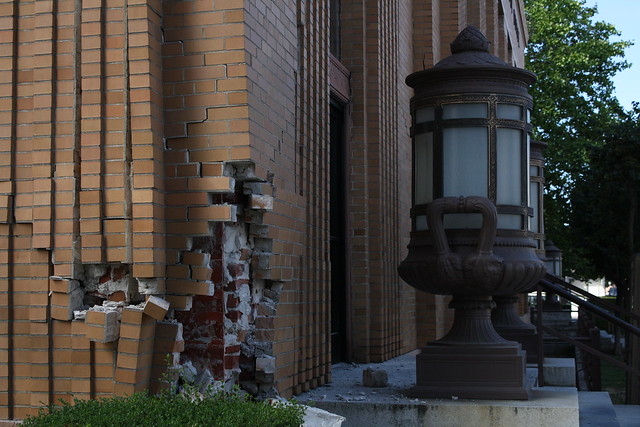
August 2014 South Napa Earthquake damage to Napa Franklin Main Post Office
Napa
The rebound of the Napa Franklin Station Main Post Office building from the depths of peril to an auspicious future can empower preservationists. Napa in 1933 was fortunate enough to have its WPA post office designed by a Napa native, architect William H. Corlett, also responsible for the Plaza Hotel, Napa High School, and the former St. Helena Public Library.
Not stinting on detailing, Corlett included external terracotta friezes of ram heads interspersed with oval shields (unique among post offices), and seven grooved pilasters topped by terracotta floral images between large windows. Inside the public lobby, observant visitors are rewarded with a corresponding star pattern both in bas-relief gilt plaster in soft pink/gold/blue on the twenty-foot ceiling and in the same position separated by marble strips on the terrazzo floor. Marble wainscoting, detailed woodwork, drop lights, and brass post office boxes further contribute to the early Thirties Art Deco “WPA Moderne” style, while two cast bronze and milk glass urn-shaped lighting fixtures edge each of the two lobby entrances. Above each door is an Art Deco eagle mounted in terracotta.
Despite a slight 1965 modification, design functionality left the floor plan unaltered over many decades, and the post office was placed on the National Register of Historic Places (NRHP) in 1985. Along the way, the building witnessed an anxious gathering of 165 “enemy aliens”, mainly of Japanese, German or Italian origin, for mandatory registration shortly after Pearl Harbor, and those of these ethnicities, citizens or not, were banned from (“sensitive”) southwestern areas of the city of Napa. Of the 165, 42 Japanese were subsequently removed to internment camps.
Coinciding with a USPS predicament of declining first class mail income and steep pension liabilities, the August 24, 2014 South Napa Earthquake struck Franklin Station a near lethal blow. Extensive damage included lengthy twisting wall cracks exposing underlying red brick, building corners cracked and tilting, shifted brick columns, and scattered stone chunks on lobby counters and floor. The tall lobby windows were shattered, and both plaster walls and ceiling and the lobby marble wainscoting were fractured. Asbestos contamination occurred, which initially hampered retrieval of trapped mail.
Fortunately, some eminent historical features were only lightly affected, or escaped harm altogether. Such terracotta items as the cornice with rams/oval shields design, window moldings, eagle panels above lobby doors, and certain other panels emerged intact. The notable lobby ceiling bas-relief gilt plaster, the original hanging lobby lamps, the lobby terrazzo floor, and the general internal layout came through in good shape. The sizeable basement was largely unaffected. Most crucially, the simple Art Deco geometry of the building design, expressed by a protruding central block anchored by two recessed wings, remained as powerful as ever. In an NRHP Nomination Amendment for Franklin Station dated February 4, 2015, consultant Tetra Tech, Inc. cited these findings among others as evidence that the structure continued to merit its NRHP listing, and this was certified by Daniel B. Delahaye, USPS Federal Preservation Officer, and Dr. Carol Roland-Nawi, California State Historic Preservation Officer.
Still, local preservation non-profit Napa County Landmarks had the prescience to place Franklin Station on its Ten Threatened Treasures List in June 2015, days before a letter sent by Delahaye indicated for the first time a USPS demolition plan (an NRHP listing requires the USPS to notify local governments, other agencies, and some historic preservation bodies of demolition intentions in advance, and a 30 day public comment period).
Local opposition gathered swiftly. In support of its decision, the Postal Service stated that $8 million would be needed to restore the building, in contrast to a $500,000.00 demolition cost. But Julianne Polanco, successor to Carol Roland-Nawi, responded to the USPS that the Delahaye letter gave no factual rationale to support the estimates, such as structural reports, economic analyses, or existing condition assessments. Ken MacNab, Napa City Planning Manager, faulted the Service for resting its case on a simple cost contrast, without considering reuse options. Architect Juliana Inman, a Napa City Council Member, suggested that the $8 million figure might cover a total overhaul, and that basic repairs could be made for much less. The National Trust for Historic Preservation hosted an online anti-demolition petition and its Senior Field Officer and Attorney in San Francisco, Brian Turner, exhorted advocates, “Don’t fizzle out. The Postal Service needs to hear from you and they need to hear it again and again.” Napa Mayor Jill Techel and Rep. Thompson also campaigned to save Franklin Station.
In mid-summer 2015, a common theme resonated that prior to its conclusion the USPS did not consider working with potential partners or buyers to realize sympathetic building uses, and did not receive public comments from the process outset. Although other communities have struggled for years, sometimes failing, to save old post offices, the USPS perhaps “felt the heat” (or got religion), announcing in early August a sudden and welcome switch to sale of Franklin Station.
But Napa preservationists postponed the bubbly, knowing that everything would depend on the eventual buyer and its plans. Napa Valley Landmarks hosted an August 10 public meeting addressed by Harvey Smith, founder of Citizens to Save the Berkeley Post Office, and Jacquelyn McCormick, founder of National Post Office Collaborate. Smith and McCormick won their spurs by tenaciously resisting an obdurate USPS effort to sell the Berkeley Main Post Office without preserving public access to it, a standoff that continues to the present. They emphasized the indelible public nature of tax financed facilities built to serve communities, and offered several suggestions for the long fight that might prove necessary in Napa. From their experience, local mass movements to show the USPS it is under continual scrutiny could be broadened from preservationists and participatory residents to include politicians, attorneys, journalists and labor unions. McCormick pointed out that for Franklin there was not simply a binary choice of continuing as a post office or sale, but a third possibility of postal services mingled with other activities.
USPS spokesman Dean Cameron did say that if a buyer wanted to lease a portion of the building to the USPS, the agency would consider moving back in. However, as time went on the community could not assess buyer plans because of a lack of buyers. Local developers were sobered by the damage extent and the imperative of respecting historical fabric. They also had concerns centering on retrofitting and zoning. City Planning Manager MacNab acknowledged that once the parcel was sold, the zoning would need to be updated to “downtown mixed-use”.
The sun broke through in March 2017 when longtime Napa developer Jim Keller, seeing current conditions more as opportunities than as obstacles, purchased Franklin Station for $2 million to create a hotel. And not an anywhere hotel: “It will be authentic. The post office is going to be shining bright,” he promised. Keller estimated that he will spend an additional $6 to 8 million to renovate and repurpose.
Juliana Inman, who had always made clear her first preference of Franklin remaining what it was, was nonetheless well pleased with Keller’s plan. “The community can consider this a big success because we stopped the demolition and got the (USPS) to sell it. I’m very optimistic about its future.” The USPS adapted by making a temporary facility at Second and School Streets permanent, and by transferring some functions to another facility at Trancas Street.
Keller will preserve about 20% of the historic structure from the tan brick main façade and columns to the depth of the lobby (for which the Napa Landmarks Trust holds a conservation easement) and the front staircase. He expressed interest in applying for an exemption to the 60 foot height limit, possibly to include a rooftop lounge. The complex will include the former Zeller’s Ace Hardware site to the south, and on a surface parking lot to the east Keller will erect an automated parking garage, 65 of 228 spaces for the public, with adjoining retail space. In a separate arrangement with the Napa Housing Coalition, he will build affordable housing in another area of Napa.
In November 2018, the City Council unanimously granted rezoning and a building agreement for Franklin Station conversion to the core of a 163 room hotel extending back and upward from the original structure. Keller’s project design has likewise been approved by the Napa Planning Commission and the Cultural Heritage Commission (which oversees any plans to modernize historic buildings in the city). Keller is to submit a building design to the city by late 2020, and to line up financing and building permits by 2023.
In the Bay Area we’ve grown used to seeing venerable old buildings (“the kind they don’t build anymore”) transitioned to tourism-related uses. Sometimes there is a visceral feeling that this should stop, before we become one giant visitor attraction, if we haven’t already. What about using them directly for our denizens? But at least we still have the buildings, freshened up as they are—and who knows? Perhaps in a century they will serve uses as unexpected now as their current ones would have been to the times when they were built.

Richmond Main Post Office today
Richmond
The story of the Richmond Main Post Office to date is one of community victory, tempered with caution and vigilance. A USPS sale and shuttering plan was recently averted, but may be resumed at any time.
Built by the Treasury Department in 1938 and opened the following year, Richmond Main’s villa-like shape and spare detailing convey the fluid assurance of Art Moderne. Caught in the current of the time, it was a military enlistment location, and, like Napa’s Franklin Station, was where those of Japanese origin, regardless of citizenship, officially registered as “enemy aliens”. It was also a designated bomb shelter.
Richmond Main continued to serve through Richmond’s demographic changes during and after the war, but time was not kind to it or its downtown location. In the Sixties many longstanding downtown properties, some of historic significance, were razed for “urban renewal”, and this was spurred into the Seventies by development of the Hilltop Shopping Center, completed in 1976. Perhaps coincidentally, in the same year the main post office interior, particularly its lobby, was insensitively remodeled, although fortunately the exterior was left alone.
Unsettlingly, the removal of an original lobby mural in ’76 went unnoticed until 2014, when a community member alerted the Richmond Museum of History that “Richmond Industrial City” by Victor Arnautoff, commissioned by the Treasury Section of Fine Arts and installed in April 1941, was missing. This was not due to artist obscurity, as Ukrainian-born Arnautoff was the artistic director of San Francisco’s Coit Tower New Deal murals, and a Stanford University professor. A retired janitor located the mural in a labelled crate in a disused area of Richmond Main’s large basement, but neglected though it was, it remained USPS property. The Museum negotiated for many months to obtain the mural for restoration, but in the meantime the basement was subject to water leak flooding (resultant mold caused a temporary closing of Richmond Main in 2015.) The USPS finally transferred the mural to the Museum, which was exultant to find that it had been so carefully packed in ’76 (by conservator Nathan Zakheim, son of New Deal artist Benjamin Zakheim) that it avoided water damage. But it still requires a refresh, and the Museum is now raising funds for the approximate $50,000.00 cost, which includes the removal of toxic lead from the back of the canvas.
Richmond Main next came into the news with a jarring USPS announcement in January 2017 of plans for termination and sale (the USPS lost approximately $5.6 billion in FY 2016). As it had done in the cases of many other post offices, the Service claimed that Main was too big and no longer functional. It said that Main’s retail operations, its sole activity, would be relocated to the McVittie Annex Facility about a mile away, where letter carriers were already based.
The people and government of Richmond were well supplied with contrary arguments. The Main Post Office, a landmark, historic locale and community focal point, then as now, serves numerous staffers of neighboring Social Security Administration, Kaiser and Alameda County offices, in addition to many small businesses and nearby residents. The USPS had already closed the Station A Post Office at 200 Broadway. Without Main, there would be only two other post offices in the central area of a city of 110,000 (although post offices in San Pablo, El Sobrante and Mira Vista also serve Richmond as a whole.) Moreover, the McVittie location, at the junction of two dead-end streets, is isolated, not easily accessible by BART/bus, and has little public parking. Most fundamental was a sense that this would be a blow to a community that, despite its rich history, is widely seen as underserved and beset by ongoing socioeconomic ills.
The USPS had a lonely job defending its intentions. The revitalization organization Richmond Main Street, Richmond Mayor Tom Butt, the Richmond City Council (resolution unanimously adopted), U.S. Rep. Mark DeSaulnier (D-Concord) and the Iron Triangle Neighborhood Council soon mobilized an outreach, letter writing and e-mail petition campaign. The USPS held a public meeting on May 31, and offered a 30 day public comment period from that date, but at its close, the Mayor’s Office and Richmond Main Street submitted at least 250 letters and 113 online signatures decrying the move. Also in mid-June, Iron Triangle held a Town Hall meeting packed by residents, businesspeople, community leaders, and officeholder representatives, at which not a single speaker supported the USPS position.
A particularly passionate message came from Berkeley Mayor Jesse Arriguin: “the City of Berkeley remains steadfast in our fight of over five years to save the historic Berkeley Main Post Office. As a neighbor of the Richmond community, we also stand in solidarity with the efforts of this community to save its public commons.” Tom Leatherman, General Superintendent of Rosie the Riveter/WWII Home Front National Historic Park, urged the USPS to recognize the Main Post Office’s importance in the World War II connections Richmond seeks to highlight.
Section 106 of the National Historic Preservation Act mandates federal agencies to undertake a series of steps, including a 30 day comment period, before commencing activities that will impact properties they own which are either listed in the National Register of Historic Places (Richmond Main is not) or eligible for such listing (which Richmond Main is). Accordingly, the USPS held another public comment period from August-September 2017. In the midst of this, it offered to sell Main to the City of Richmond for $2,020,000.00 with strict conditions, including a requirement that the City provide 1,576 net square feet for retail purposes for 50 years rent-free![ii] But attorney Brian Turner of the National Trust for Historic Preservation indicated that it was premature of the Service to make such an offer before concluding the Section 106 process.
Despite the City’s efforts to acquire the Main Post Office, and in disregard of community opposition to the “McVittie Plan”, the USPS listed Main for sale in December 2017 and again in February 2018. However, in a move with echoes of its disownment of demolition for Franklin State in Napa, on July 16, 2018 the USPS put its sale plan on ice, citing “changing market conditions.” At the same time, it asserted its right “to pursue a disposal undertaking”, stating that in this event it will “reinitiate” Section 106 consultation.
Thus Richmond Main continues serving the public as it long has. In a step hoped to facilitate Main’s National Registry of Historic Places listing, in February 2019 it was officially renamed after Harold D. McCraw, a 45 year USPS employee who served as Richmond Postmaster (the legal motion courtesy of Rep. DeSaulnier). But listing will not keep at bay corruption of its historical integrity. Part of the preservationist mission is to ensure that rising property values and USPS fiscal woes do not in tandem push the Main Post Office into oblivion.
Footnotes
- Ukiah Main Port Office construction funded by the Treasury Department (not Works Progress Administration, according to https://livingnewdeal.org/projects/old-post-office-ukiah-ca/.)
- Richmond Main Street states that the USPS sale offer included “city providing retail space of 1,576 net sqft for 50 years at zero rent”, while the September 25, 2017 letter of Brian Turner, National Trust for Historic Preservation, to Ann Sarver, Facilities Environment Specialist, USPS, reads that the offer required a “50 year no-rent leaseback”’
The author is very grateful to:
- Ukiah attorney Barry Vogel (for extensive verbal and written information on the former Ukiah Main Post Office.)
- Jacquelyn McCormick, Senior Advisor to the Mayor of Berkeley and Founder, National Post Office Collaborate.
- Brian Turner, Senior Field Officer and Public Lands Attorney, National Trust for Historic Preservation, San Francisco.
- Gray Brechin, visiting scholar in the U.C. Berkeley Department of Geography and founder and project scholar of the Living New Deal.
Image Permissions
- Header image via Wikipedia user Sanfranman59
- Ukiah Post Office image via Wikipedia user Ian Poellet
- Napa image © Matthew Keys
- Richmond Post Office image © Melinda McCrary
Help restore “Richmond Industrial City”
The Richmond Museum of History is raising funds to restore “Richmond Industrial City, by Victor Arnautoff, the mural which had formerly been displayed in the lobby of the Richmond Post Office. Make a contribution, while enjoying an evening of food and entertainment, by purchasing tickets now for A New Deal for Richmond, Arnautoff Mural Benefit Dinner. The fundraising dinner will be held on Thursday, September 12th at the Historic Rockefeller Lodge in San Pablo.
Mural image © Hannah Anderson, via the Richmond Museum

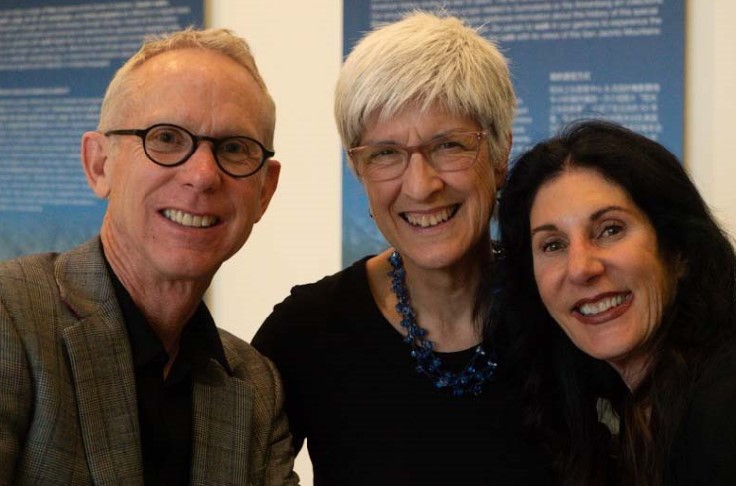
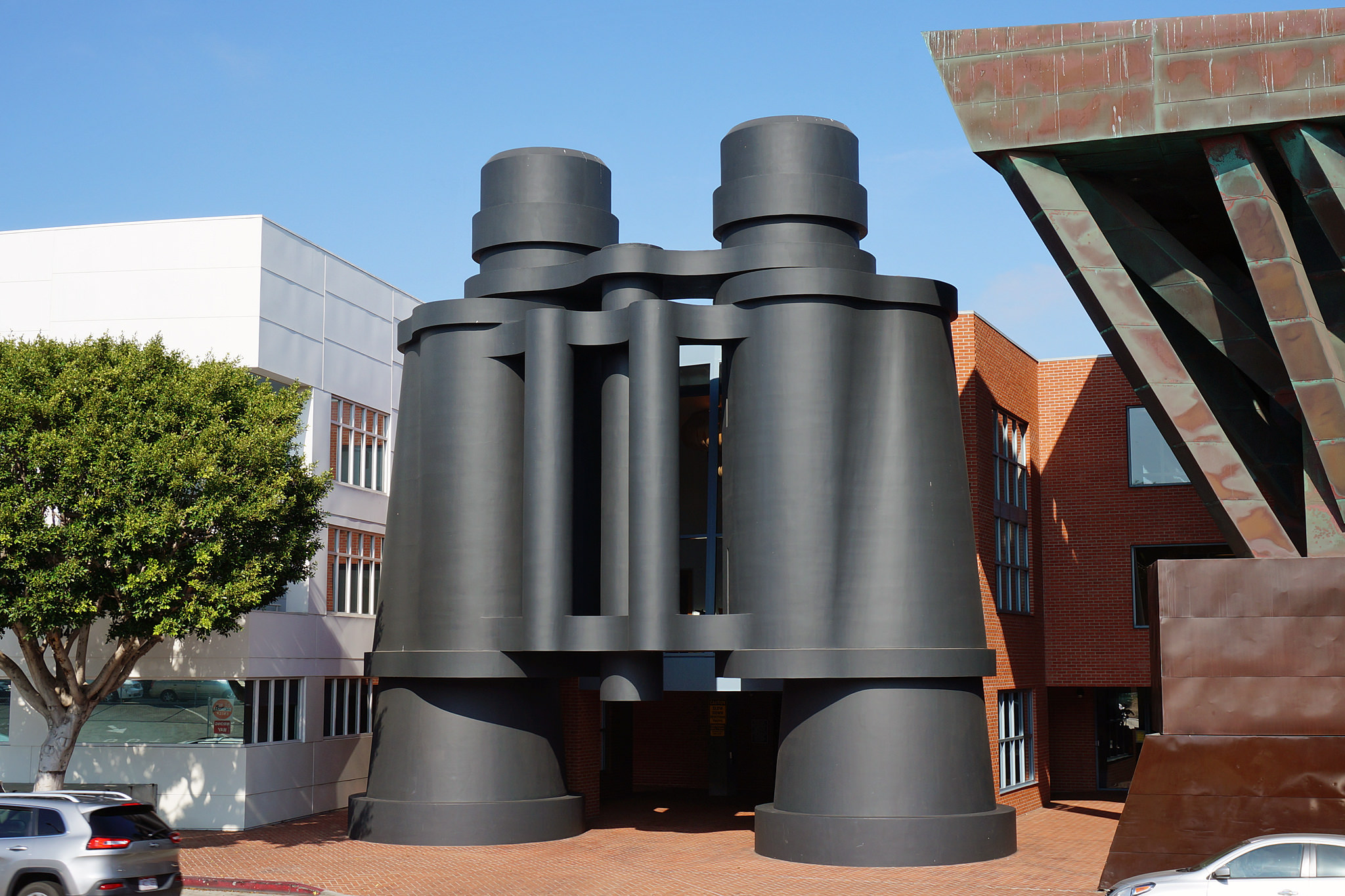
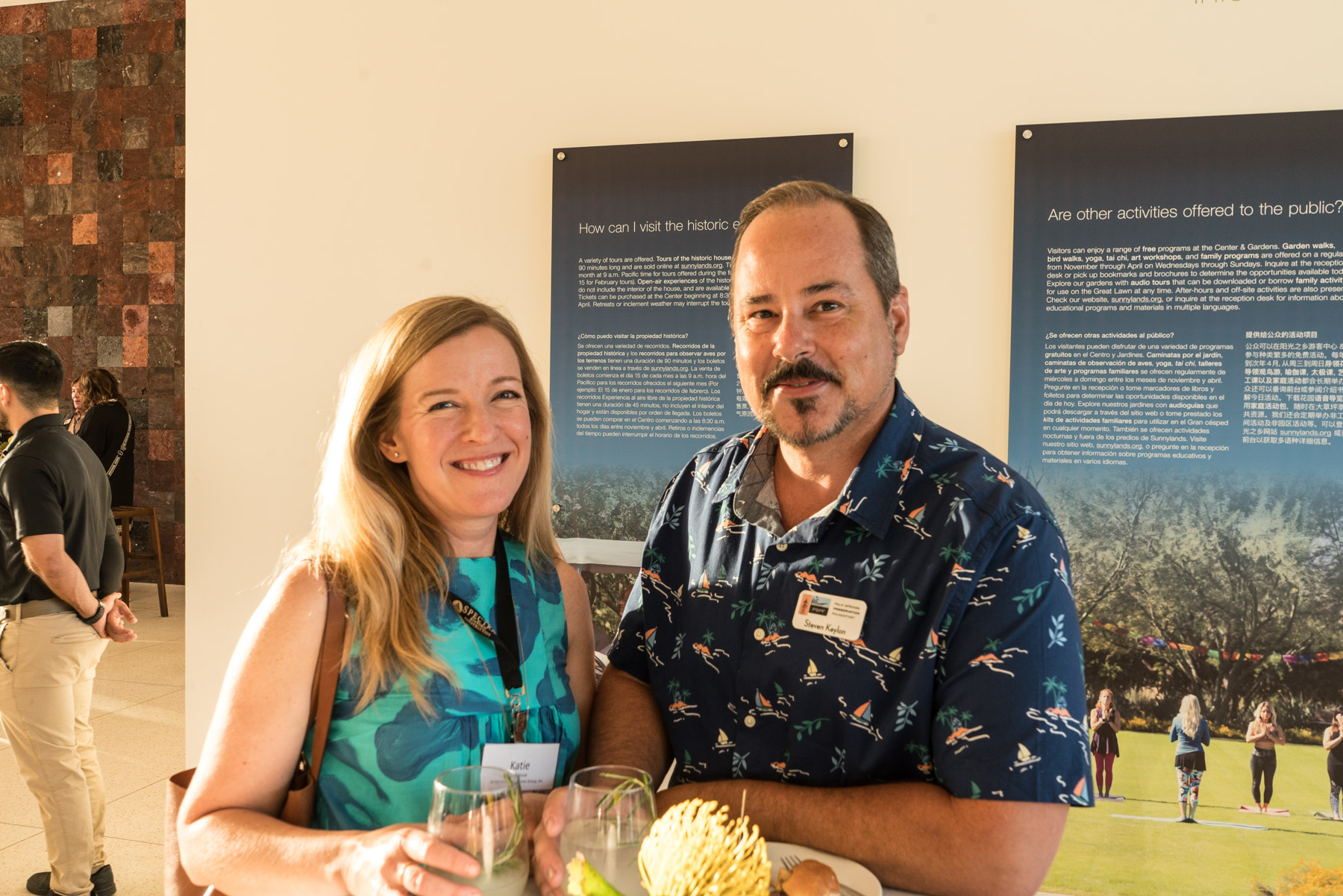
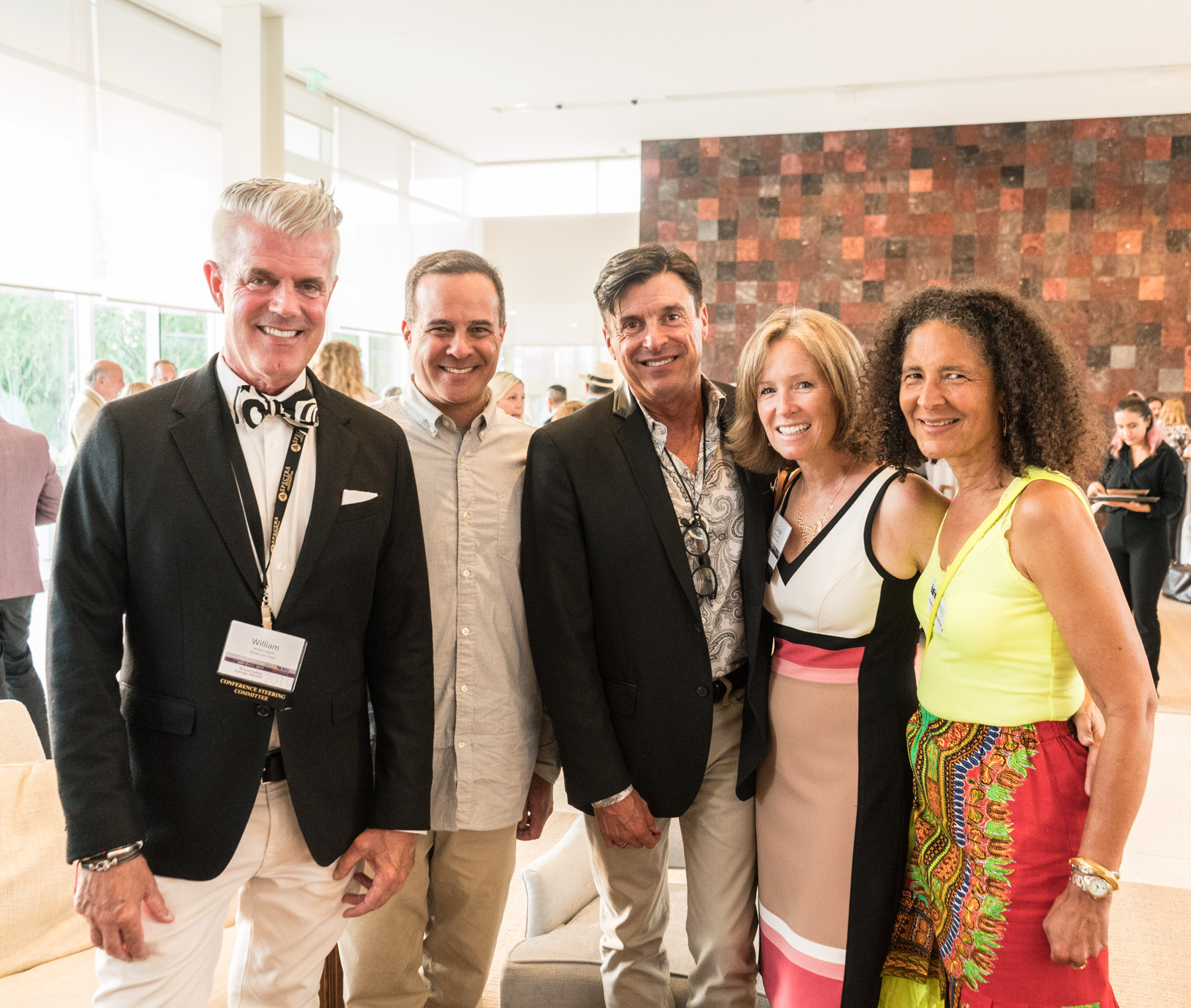

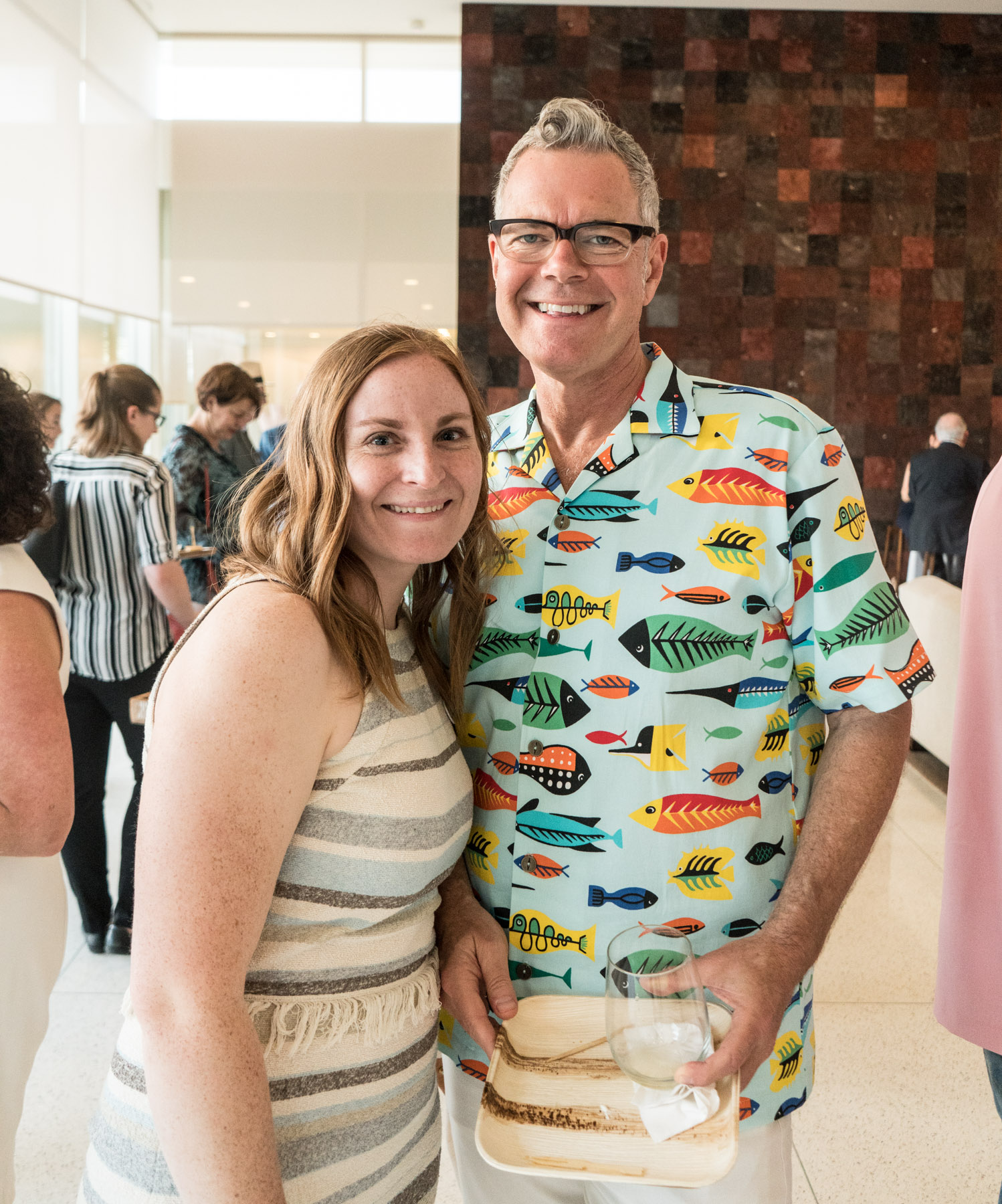



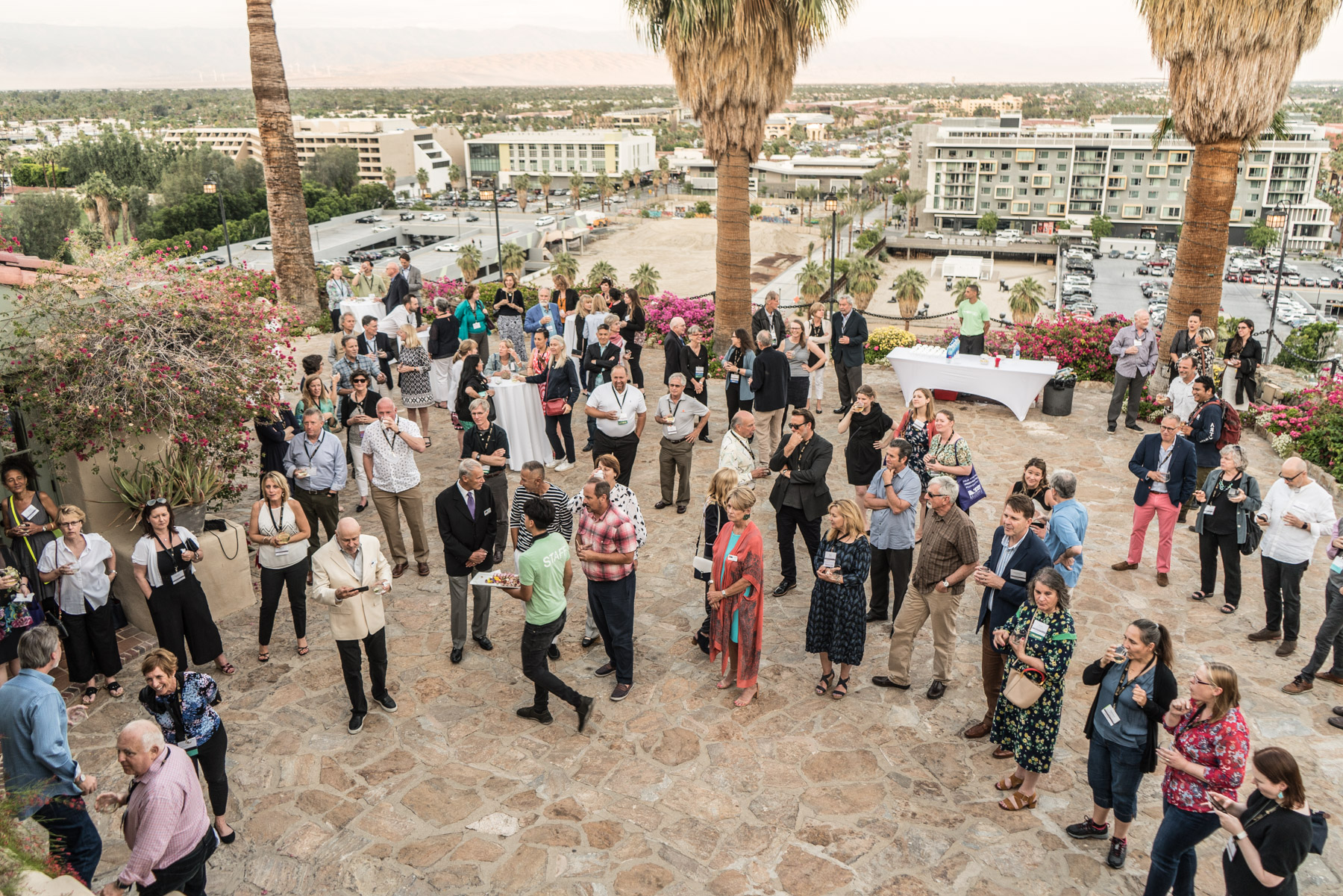
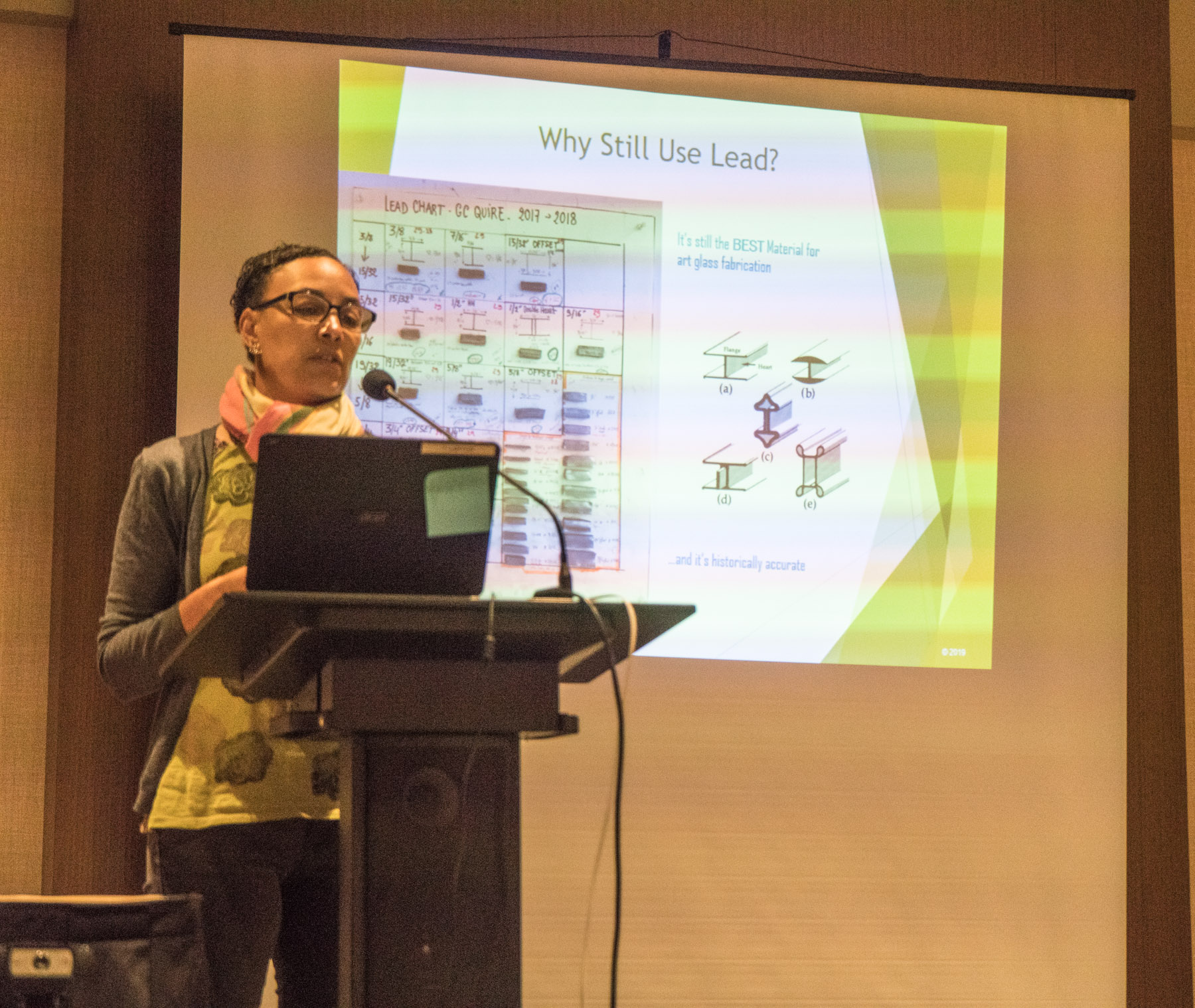

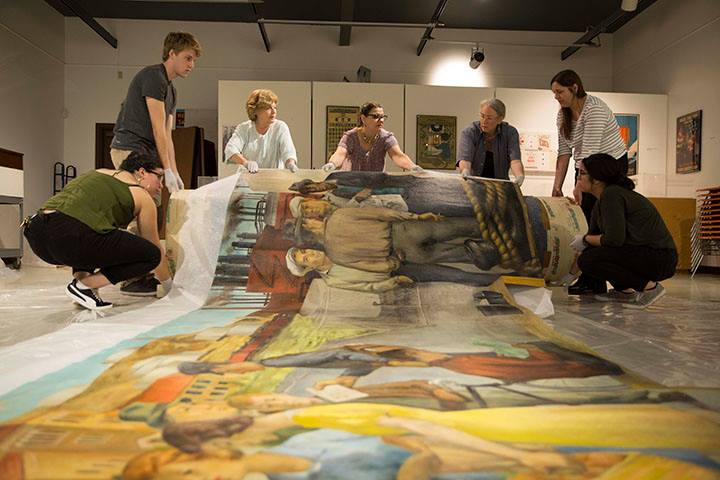
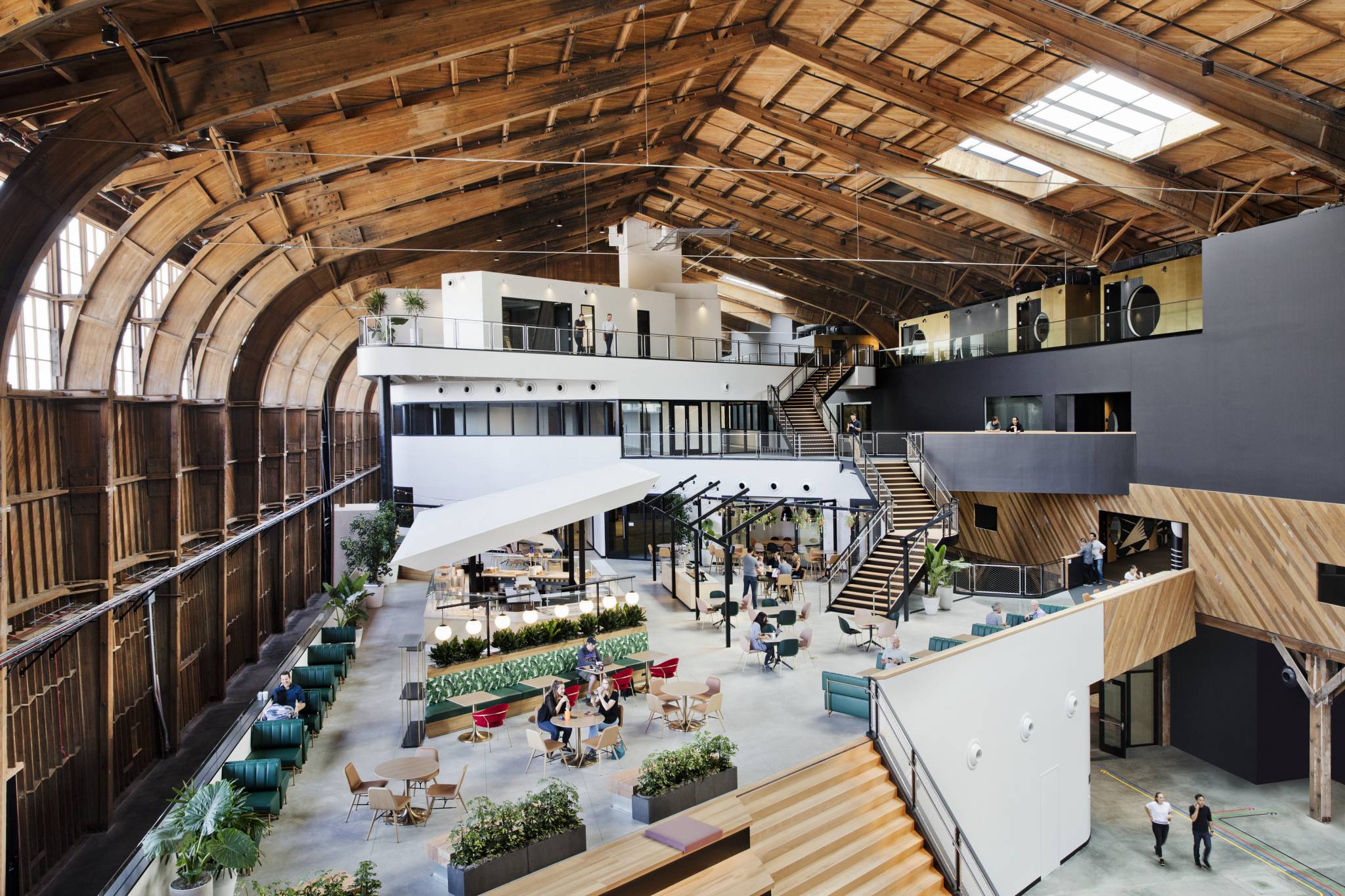

We at Preservation Action Council*San Jose seek to restore the clock tower on our old PO – see http://www.sjclocktower.org
any help or suggestions would be appreciated.
John Mitchell
Board – PAC*SJ
http://www.preservation.org